Making CSR Integral to Our Autonomous Digital Enterprise Journey


Alongside our customers, BMC is on a corporate social responsibility (CSR) journey toward becoming an Autonomous Digital Enterprise (ADE) that includes everyone. To quote our CEO Ayman Sayed, “Every Autonomous Digital Enterprise has a social responsibility. And that responsibility is to reshape the business landscape to be more inclusive and play an active role in global issues and opportunities—from addressing climate change to implementing diverse and equitable practices and preparing all communities for their digital future.”
Reflecting on 2021, we have made significant progress building out a formal CSR strategy that will allow us to make an even greater impact in our communities in 2022. Centered on three key pillars—our BMC Cares program; diversity, equity and inclusion (DEI); and environmental stewardship. I’m incredibly proud of everything our team has accomplished during a very dynamic and unpredictable time in history.
A defining moment in CSR
I’m incredibly honored to share that BMC ranked fifth among 992 software and services companies as measured by the Environmental, Social and Governance (ESG) Risk Rating, issued by Sustainalytics. We were in the top one percent of all 14,980 companies measured on their exposure to industry specific, material ESG risks and how well a company manages those risks across all sectors. With our commitment to investing in ESG initiatives, this honor validates the investments and initiatives we’ve taken across BMC to prioritize this aspect of our business. We are passionate about delivering great technology and making the world a better place in the process.
Joining a global movement
As pleased as we are with our rating, we recognize that this is an area that requires well-defined goals, combined with continuous improvement and diligence. We’ve set a high bar for 2022 that includes addressing climate change, arguably one of the most significant issues of our time.
The Intergovernmental Panel on Climate Change (IPCC) recently reported that every half-degree of the global temperature makes a tremendous difference, which is why BMC has joined the Business Ambition for 1.5° C campaign established by the Science Based Targets Initiative (SBTi), a partnership between the Climate Disclosure Project (CDP), the UN Global Compact, World Resources Institute (WRI) and the World Wildlife Fund (WWF).
As part of our commitment, BMC is dedicated to achieving science-based, emission reduction targets across our business to reach net-zero value chain emissions no later than 2030, which aligns with the United Nations Sustainable Development Goals (UN SDGs).
As part of endorsing the SBTi campaign, BMC has disclosed its emissions and net-zero carbon goals and current climate footprint. In addition, we’re committing to the CDP and SBTi targets that go beyond our company’s electricity consumption and emissions to include reporting the carbon footprint of the products we sell and buy.
BMC also supports the environment through other initiatives, including our ongoing partnership with Reforest’Action and One Tree Planted. In 2021, we helped plant over 20,000 trees across 38 countries, and we collaborated with the Seabin Project, Ocean Conservancy and #TeamsSeas to remove trash and debris from the world’s waterways.
CSR - it's never done
Looking ahead to 2022, we see more opportunities to improve the world for our employees, customers and partners. We continue to set aggressive milestones for ourselves in all three pillars of our CSR strategy, and we look forward to making even greater progress. As a recent op-ed in The Hill put it, businesses that “take advantage of this unique opportunity will find themselves at the vanguard of a movement that propels their company and the world at large into a new era of prosperity.” We embrace this opportunity to create a planet and Autonomous Digital Enterprise that includes everyone.
Interested in having your voice heard on 3p? Contact us at editorial@3BLMedia.com and pitch your story idea to us.
Previously published on the BMC Beat Blog.
Image credit: Patrick Tomasso via Unsplash
If Only Betty White’s Iconic TV Character Had These Smart Home Products at Hand
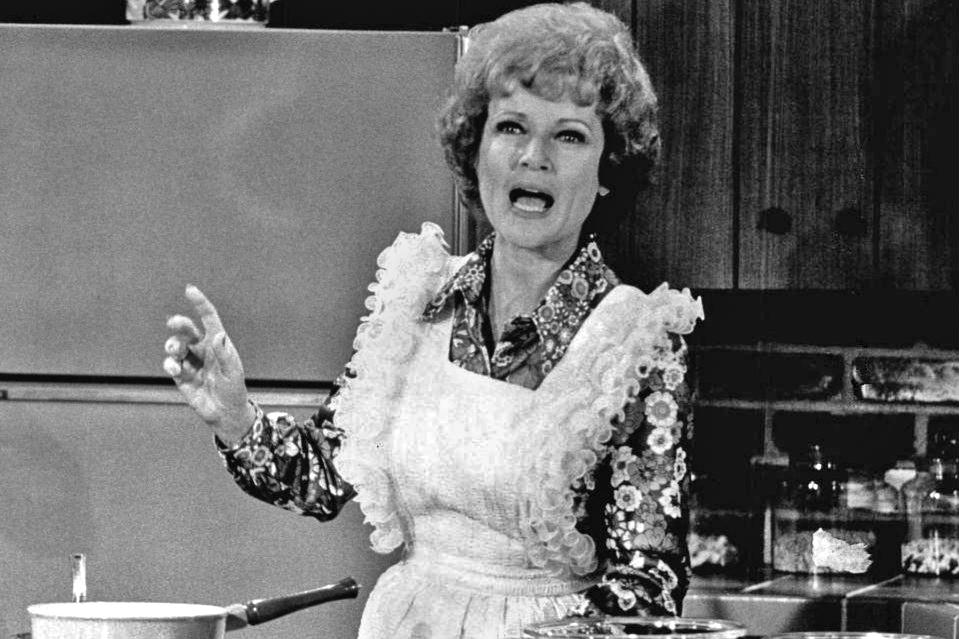

Perhaps your holiday wish list wasn’t fulfilled last month, but there’s no reason why you can’t relaunch it. When it comes to the home, companies are rolling out more products to make domestic life more energy efficient, safer and also, quite frankly, more fun. Meanwhile, with the timing of events like CES now underway, countless companies keep improving and innovating their smart home products. Many of these appliances and devices may be pushing the household budget, but we can dream, can’t we?
Smart bath technology from Kohler makes bath time easy - and doesn’t scald
Calgon, take me away!
Today, we’ll stay out of the bath-vs.-shower water efficiency fray. For those who enjoy a bath from time to time, the mess and the oops over we got it too hot or too cold are enough to dissuade us from soaking instead of showering. Plus, all that water lost in trying to achieve the perfect bath temperature contributes to the ongoing waste of this precious resource. Kohler, however, has a solution, one parents would definitely dream about as bath time for the little ones is more stressful than soothing.
The company’s PerfectFill technology takes the guesswork out of creating the perfect bath. Announced at CES this week, this “smart bath” allows you to fill up the bathtub at your desired depth and temperature. Voice commands or an app will also let you set up to 10 various baths. Prices start at $2,700, which when considering the costs of a flooded home and subsequent bills because of one’s forgetfulness, is not too steep. One more thing – the tub will also drain at your command, but you’re the one who will be tasked with scrubbing it. The self-scrubbing tech may take a few more years.
Also available: the dreamy Stillness bath (shown below), which adds fog, light and aroma to your bathing experience. This smart home dream comes with a price, however; it’ll set you back about $8,000.

Home water security systems are fast becoming a thing
It’s been a relatively wet winter in California, but this year’s rain and snow aren’t enough to make up for several years of drought, and the future is looking bleak.
Is it time for homeowners and landlords to do their part? In much of the U.S., that answer is a yes, given that a good portion of our struggles with water scarcity have to do with leaks and other inefficiencies in our water systems.
Moen and Kohler are among the companies that are rolling out water security systems that can help make a smart home become even more intelligent and more water efficient. Moen offers a water monitor that can alert you for leaks and other problems within your home’s pipes, while a detector can flag overflowing drains, severe weather and appliance failures – and both systems work together. Kohler offers water systems that offer similar solutions – including one that will automatically shut off your home’s water supply if necessary. If you’re not moved by the impending water crisis, perhaps the threat of a pricey plumbing bill could give you that nudge to buy such devices and protect all that you’ve invested in your smart home.

If only Sue Ann Nivens had these smart ovens at her disposal
Many of the leading appliance makers tout their versions of a smart, or smarter, oven. Whirlpool is upping the ante, though. As announced this month, several of its smart ovens are scoring an air fryer upgrade, one that will occur remotely – just be sure you have the app and wireless internet working. In case you’re still using gallons of vegetable oil to make French fries, air frying has become a thing because of its easy, energy efficiency and health benefits – as for the latter, even the Cleveland Clinic is on board. Eating smarter in your smart home? It doesn't sound so far-fetched.

Now if only the late, great Betty White’s character, Sue Ann Nivens (shown above), had a smart oven with a safe soufflé option while the actress made her mark on the Mary Tyler Moore show back during the 1970s:
It’s more than a fridge, it’s a kitchen assistant
Chatter about the potential for smart refrigerators has been ongoing for over a decade. Is relying on internet of things (IoT) technologies really smart with the risks of malware and other threats? Are the added costs really worth the expense, especially as refrigerators have become more energy-efficient (but often have shorter life spans) over time?
Samsung’s Family Hub seeks to put those collective eye-rolls about smart fridges aside. Yes, there are the features that might nudge you to forget about the Fire TV, with a bevy of entertainment features that make having only an Alexa Dot in the home seem so last decade.
But at a time when food waste is still very much a problem nationwide, smart fridges are among the solutions we need to help us send less food to the trash. Among the bells and whistles that the Family Hub boasts include the ability to tap and see what’s in your fridge, as well as technology that offers meal ideas and recipes based on what foods are stacked on the shelves.
If you have the budget and find the popular stainless steel look to be cliché, the Family Hub is available in an impressive range of colors, too.

Rounding out the smart home - LG keeps improving its smart washers and dryers
The electronics manufacturer is among the companies making its presence known at CES, with its latest FX washer and dryer scoring swell reviews. Artificial intelligence takes the guesswork out of much of the tasks surrounding laundry, including measuring the perfect amount of detergent and heat allowing consumers to save water and energy – while reducing the annoyances involved with checking the dryer yet again to see if the clothes are dry. Spend a little more coin and a pet filter paired with a software upgrade. The cost for both starts at about $3,300 and will be available later this year.
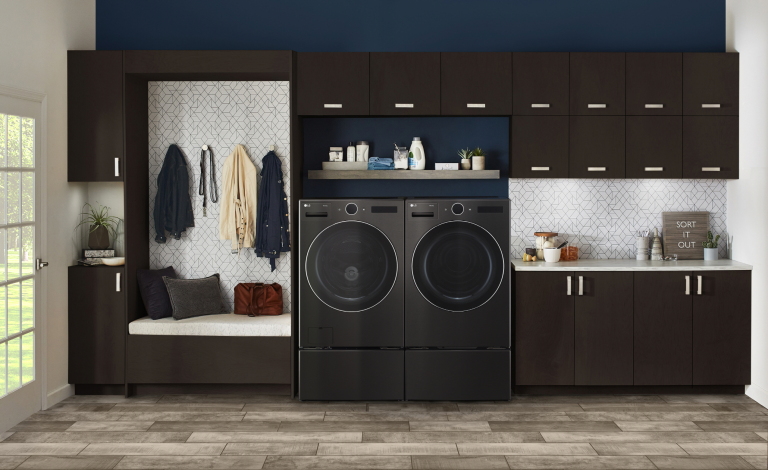
Image credit: CB Television via Wiki Commons
What Type of ‘Exhausting’ Work Is Required for Climate Progress in 2022?


The Times Square Ball has dropped, marking a new year for the western calendar — and growing sense for climate progress. Just days before the turning of the calendar, new German Minister of Economy and Climate Protection Robert Habeck told German national weekly Die Zeit, “We will probably miss our targets for 2022. ... Even for 2023 it will be difficult enough. We are starting with a drastic backlog.” He said the new year would be “exhausting” for the ministry.
While other nations haven’t made such bold announcements, organizations like the United Nations Environment Program (UNEP) have made it clear that, as a whole, G20 members are projected to fall short of their 2030 pledges. The Nationally Determined Contributions (NDCs) updated during the recent U.N. climate conference only shave about eight percent off of predicted 2030 emissions, the UNEP shared in its Emissions Gap Report from last October. If nations were preparing to meet the 1.5 °C Paris goal, they would have pursued a 55 percent drop, the UNEP added.
Clearly Germany isn’t the only nation falling behind. As the new year begins, it’s useful to take a look at the trajectories of the world’s top greenhouse gas emitters. Habeck noted that Germany will focus in part on a doubling or more of the number of wind turbines built this year. On that point, what sort of hard work is ahead for other nations, and where are the open doors and where is resistance?
China: pushing forward climate targets
Generating over half of the world’s coal energy and about a quarter of global greenhouse gas emissions, China takes its rightful place at the top of the list. The industrial powerhouse has remained the top investor in renewable energy since 2013, when it overtook Europe, but it has set modest climate goals, such as reaching peak carbon dioxide emissions before 2030 and becoming carbon neutral by 2060. We may see a shift in these goals in 2022. In a piece for The Conversation, Professor of Environmental Diplomacy at DePaul University Phillip Stalley predicted that the increased number of climate pledges announced at last year’s climate summit, as well as a new and unexpected partnership with the U.S., could help to nudge China toward more ambitious targets.
The U.S.: breaking through policy roadblocks
Yes, with its new administration, the United States has reentered the global stage as a climate leader. But actually taking such action has proven to be difficult. While Biden’s $1 trillion infrastructure package has passed through Congress, a larger spending bill has been stalled. The administration has indicated that it may rely more heavily on executive orders and rules to achieve climate progress. At the end of December, the Environmental Protection Agency (EPA) announced an increase in vehicle mileage standards to 40 miles per gallon by 2026. And earlier in the December, Biden signed an executive order that sets emissions goals across federal operations.
The European Union: shifting to bolder climate progress
While the European Union has been a climate leader in many ways — even pursuing the goal of making Europe the first climate neutral continent by 2050 — the research group Climate Action Tracker has rated its overall efforts “insufficient.” A study published late last year found that Europe will miss its 2030 target for reducing greenhouse gases by 55 percent by 20 years. Instead of relying on incremental change, the EU should start taking bold action, Olivia Lazard writes for Carnegie Europe.
Lazard finds hope in the constitutional court ruling from March that concluded that Germany’s climate measures were insufficient to ensure a safe future and urged quick and decisive action. The government amended its Climate Protection Act in response, signaling hope for the role that democratic processes can play in keeping governments accountable and progressing, even if it requires, to quote Habeck yet again, “exhausting” work on the climate progress front for the time being.
Image credit: American Public Power Association via Unsplash
How the Pandemic Set Back Progress Toward Ethical Working Conditions
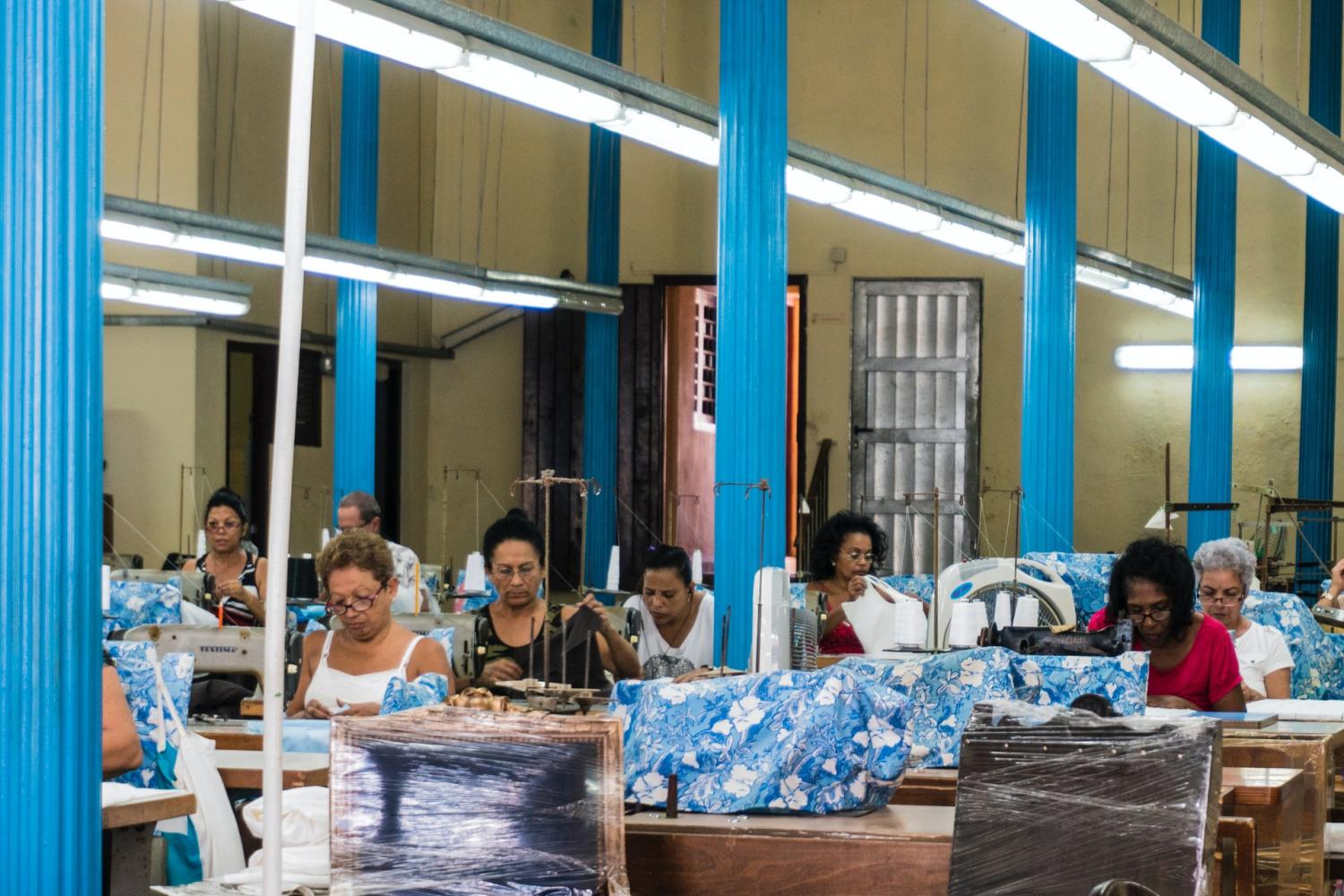
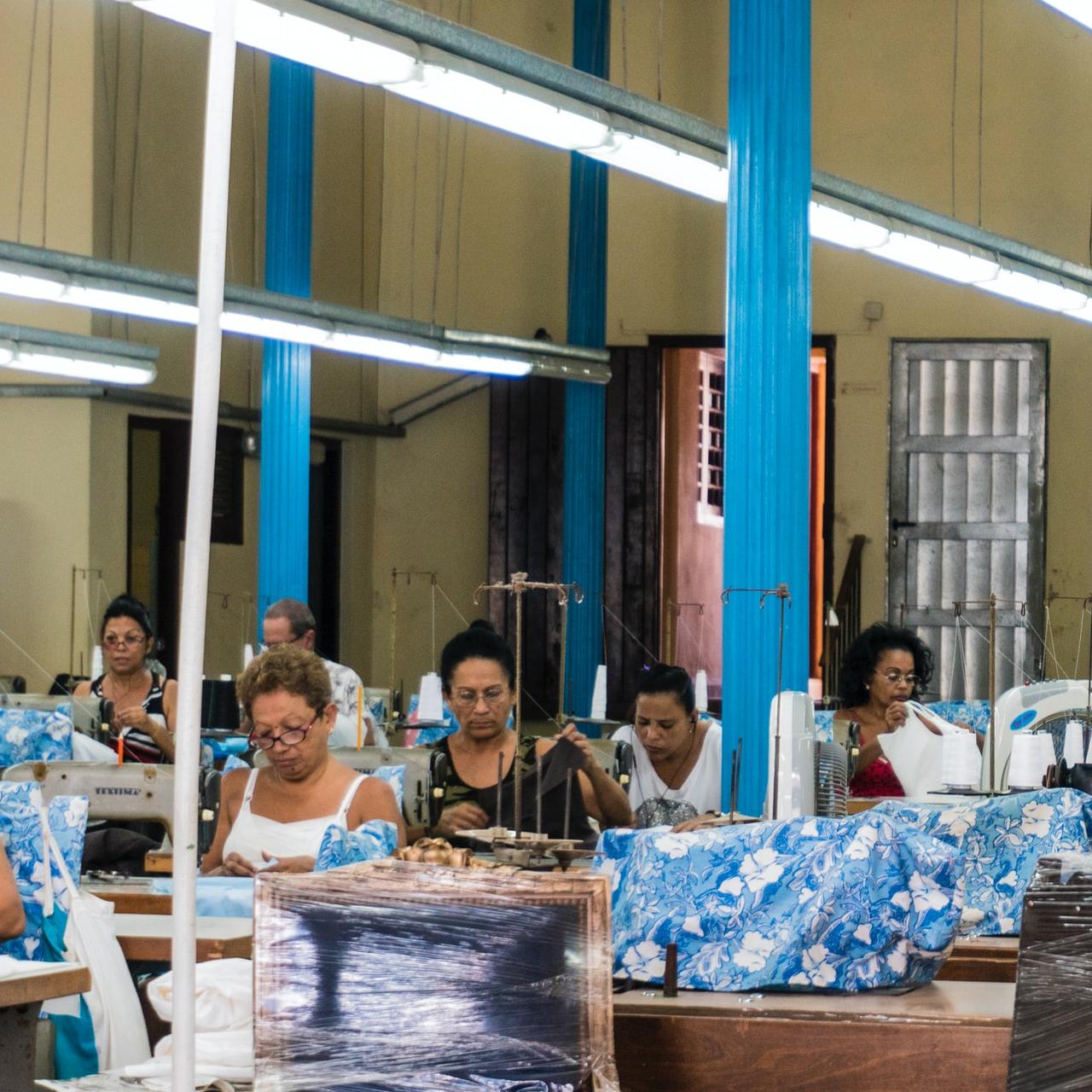
One unexpected consequence of the COVID-19 pandemic starting to come to light is a setback in a long-standing progression toward ethical working conditions in factories. While the immediate economic impacts of our reactions to a global pandemic are fairly predictable, most of us didn’t expect (or didn’t have the time to consider) how one virus’ disruption of a globalized economy could set back years of progress in ethical working conditions.
More data, but also more non-compliance
Since the pandemic started in 2020, the number of factories failing inspections for ethical practices has gone up considerably. Supplier audit data from the international inspection company QIMA, shows a clear trend from 2020 to 2021. The number of “critically non-compliant” factories increased from 18 percent in 2020 to 28 percent in 2021. This bucks a three-year growth in progress where more and more factories were moving out of the “critical” category and into the “compliant” category.
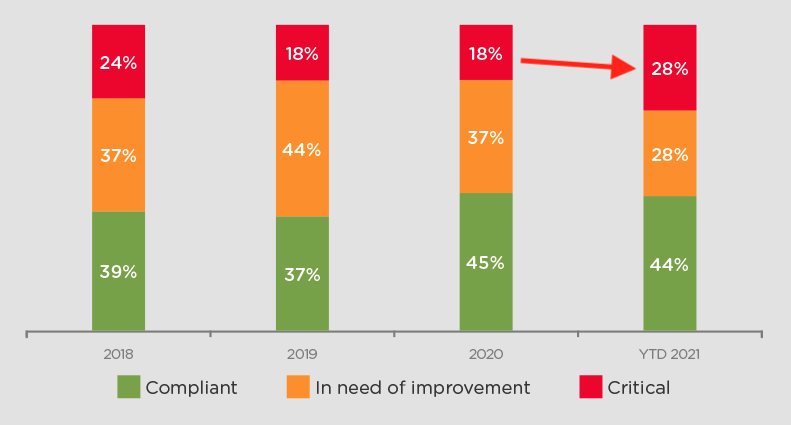
(Image: QIMA.com Q4 Supply Chain Industry Report)
These are factors most of us consider fundamental rights, which organizations ranging from small local groups to international organizations like the United Nations have been working on for decades. Since the industrial revolution factory working conditions have slowly evolved to be better in most dimensions of ethics. The most recent reports, however, show that the ongoing pandemic has been a setback.
How the pandemic affected ethical working conditions
As was expected, the in-and-out of lockdowns across the world starting in the Spring of 2020 changed the demand for goods and services around the world. While the demand for PPE like masks and gloves soared, demand for most other products declined.
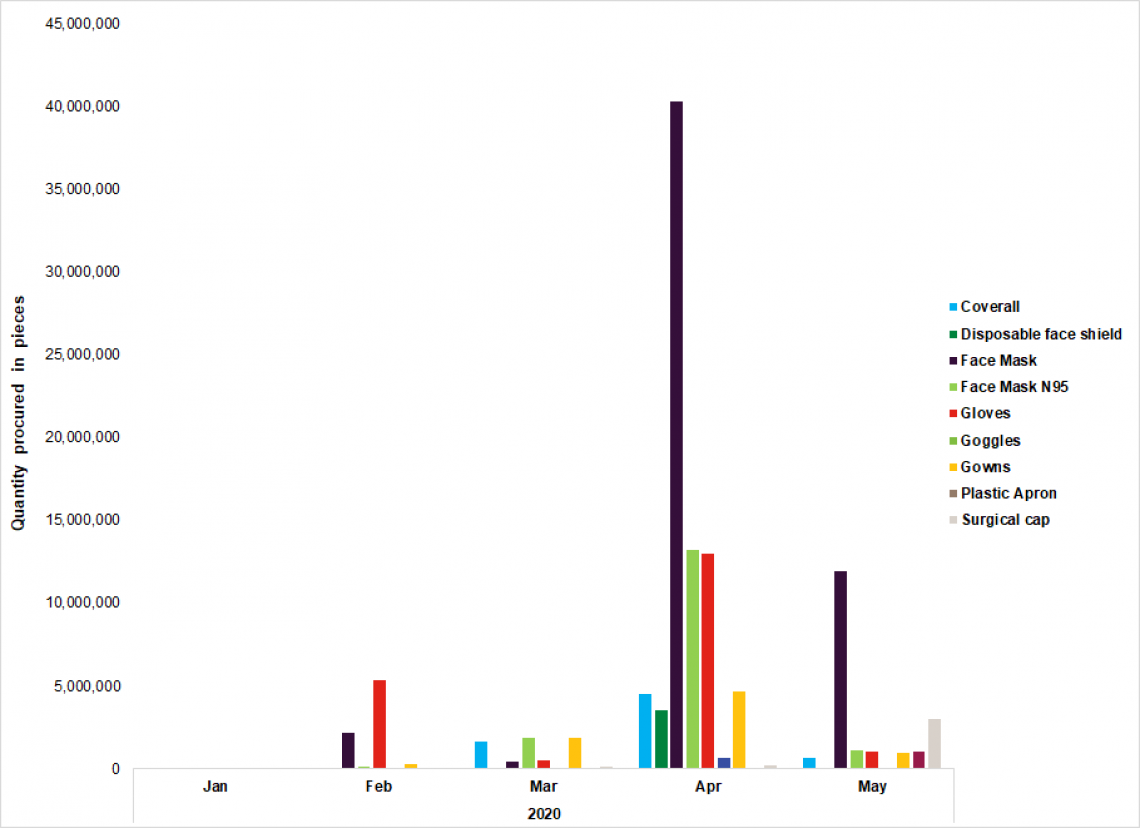
While most of us in western cities are worried about the distractions of working from home or not being able to meet up with friends, we’re now starting to realize that some of the biggest economic burdens are falling on overseas suppliers. These manufacturers tasked with producing the majority of our commodities not only saw a reduction in orders, but in some cases cancelling and nonpayment of those already in production. According to an October 2020 report from Penn State’s Center for Global Workers’ Rights, over half of the suppliers they contacted were forced to accept prices for orders below the cost of production and wait longer than usual for payments.
Furthermore, 77 percent of suppliers surveyed reported that when the pandemic disruptions first hit, they had at least some of their orders cancelled and did not receive payment.
Suppliers' struggles falls on the backs of workers
In our globalized economy the burden of unexpected events flows downstream and often lands hardest on the lowest rung of the ladder: individual workers. Fear, uncertainty, and doubt in developed countries, paired with business closures reduces consumption of goods. To compensate, brands cut down on orders as they scramble to reduce costs wherever possible. As suppliers are not paid, underpaid, or have payments delayed, they too scramble to meet operational costs and as a result, retract to unethical practices.
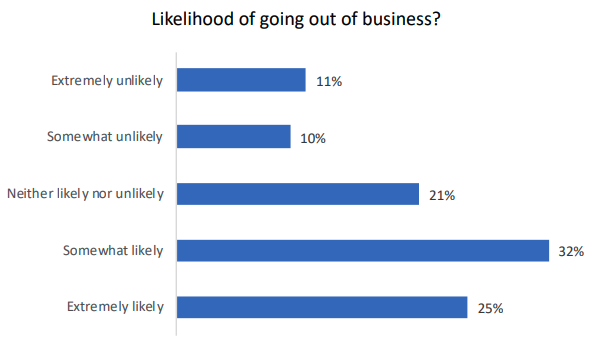
While the long-term implications of this trend are yet to be seen, it is clear that a substantial portion of suppliers are feeling the stress. Like many other changes brought by COVID-19, we hope this will be an asterisk on our timeline of progress, not a substantial setback.
Image credit: Allan Wadsworth via Unsplash
The Water Issues to Keep Your Eyes on During 2022


For years, water issues have revolved around the resource being too scarce, too abundant or too polluted. 2022 may be the year when we finally start talking about water extreme events being too frequent as well. From droughts to floods to cities with boil water notice, the intervals between events continue to shrink as climate change advances.
2022 may also prove to be a year of change for water. Significant legal and policy shifts are underway that should be on everyone’s watchlist.
The U.S. infrastructure bill begins to make a difference
While the Build Back Better bill continues to rise and fall in congressional negotiations, the codification of the Infrastructure Investment and Jobs Act in November 2021 means we should start seeing some critical investments in water infrastructure flow to cities and states. Money has already started to flow: $7.4 billion has been allocated to replace lead pipes, an arguably urgent need. About $55 billion total has been budgeted for clean water infrastructure, but that is still just a drop in the bucket for what is needed. Altogether, the infrastructure law authorizes funding for about 100 projects, but that goes beyond water to include things such as upgrades at ports, airports and roads as well as improving broadband infrastructure and cleaning up polluted sites.
Resilience is a cornerstone of the infrastructure bill. That means energy and water systems will receive an inflow of capital for improvements. Careful consideration is warranted, however, to ensure the funds address past inequities as well future scenario planning. For example, using outdated climate models to determine investments could set aside more flexible and innovative approaches to resilience planning. Traditional water infrastructure typically relies on structures such as dikes and dams, but climate change demands not only using the past as a reliable indicator of the future. The frequency of precipitation fluctuations puts pressure on systems, so building with flexibility and community needs at the forefront also require using the latest climate modeling.
While the infrastructure bill budgets around $240 billion for environmental justice projects, including water, many advocates feel it not only falls short but misdirects some of the spending towards flashier projects over systemic change. In 2022, expect to see intense scrutiny on how those dollars are spent in underserved communities.
Under the radar: water issues across the U.S. and WOTUS
Waters of the United States (WOTUS), the primary federal law that defines a waterway under federal jurisdiction, is a topic much loved by water wonks, but often fails to make headlines for the average American. It is, however, a critical component of water regulation in the U.S. On that point, 2022 could see the definition of what constitutes a federally regulated waterway change, with significant implications.
During the Trump Administration, the WOTUS definition was significantly watered down. The Biden White House reinstated the more protective 2015 definition but has also undertaken a hearing process to institute an even more far-reaching definition, with an emphasis on input from diverse communities. Traditionally, opposition to expanding regulation comes in large part from agricultural and energy stakeholders. Water regulation is a complicated process everywhere in the country, but areas where water runs low and tensions high, like Texas and California, how waterways are defined is a critical factor in water allocation and rights. The new definition, originally slated to be released in February 2022, now looks to be delayed further into the year.
Water-themed events to continue watching
The two major international events around water both have 2022 themes of making water issues more visible. The United Nations’ World Water Day in March announced the theme “Groundwater: “Making the Invisible, Visible” and the Stockholm International Water Institute’s World Water Week in August will focus on “Seeing the Unseen: the Value of Water”.
Both themes are prophetic. In a world where we rely on turning on the tap and expect clean water to flow out, the past few years have seen those expectations drowned out by reality. Communities face severe water issues surrounding its quality, and extreme weather can mean no water at all. Traditionally, the average American expects to turn on the tap and run clean water; but in addition, cheap water has created problems for the system. Many water utilities struggle to make the necessary upgrades and fluctuating temperatures and flows put pressure on the pipes, leading to damage. Water is an essential good, but there remains a disconnect between its value and its price.
As water issues around the quantity and quality of this resource become more personal to more people, pressure will mount on how we regulate, distribute and manage water resources. 2022 could see the elevation of these conversations as more money flows into communities. Water can be too much, too little, too polluted and too frequent, but all of those add up to more visibility, and hopefully, better solutions.
Image credit: Jeremy Bishop via Unsplash
After January 6, 2021: How Brands Can Fight the Next Insurrection


An FBI information wanted poster at a bus stop in Washington D.C., January 2021.
The January 6 Select Committee is approaching the public phase of its investigation into the failed, bloody insurrection of January 6, 2021, and the list of those responsible for the carnage keeps growing longer by the day. If business leaders stick to business as usual, the next coup has a better chance of succeeding. Rather than sitting on their hands, corporations can make a real difference by leveraging their financial clout and spend advertising dollars to promote and defend American democracy.
The perpetrators of January 6, 2021 are not difficult to spot
The failed insurrection of January 6 could have easily been a success. The defenders of Congress were vastly outnumbered when the U.S. Capitol Building was overrun by an organized mob of white supremacists bent on murder. But for the courage and decisive action of the defenders during a pitched, hours-long battle, the bloodthirsty mob would have succeeded.
In the year since then, blame has been assessed and there is plenty to go around.
First and foremost, of course, are the thousands of attackers who traveled long distances to invade the Capitol Building and its grounds. That includes members of known white supremacist organizations such as the Proud Boys and the Oath Keepers. By mid-January, the Southern Poverty Law Center had noted that more than a dozen extremist groups participated in the insurrection.
The finger of blame also points straight to social media. In particular, Facebook enabled these groups and like-minded people to communicate and radicalize each other, as reported in detail by the news organization such as Pro Publica.
Political observers have also drawn attention to the election fraud lies promoted by various Fox television personalities. Fox is an extreme example, partly due to its extensive contacts with former President Trump and his administration. However, Fox is far from alone. Other media organizations with a right-wing bias have also actively contributed to the “Big Lie” of mass election fraud. That includes radio and print media as well as television.
Media organizations that profess to be objective can also share the blame, through their passivity. By and large, leading mainstream news organizations have kept to the “both sides” version of objectivity, even though only one side actively supported the insurrection.
That brings up the role of Republican elected officials in the insurrection. On Capitol Hill after the insurrection attempt, 147 Republican members of Congress refused to certify the Electoral College on January 6, lending a false air of credibility to the voter fraud lies.
And, then there is President Trump, his family, and numerous members of his administration. They worked unstintingly to promote the Big Lie in the months and days leading up to Election Day 2020. They continued during the period leading up to January 6, and they persist to this day. Together, they have effectively groomed millions of American citizens to believe, without a shred of evidence, that massive voter fraud propelled Joe Biden into the White House.
The Big Lie continues
Corporate leaders were at first slow to condemn the January 6 insurrection as an act of terror organized by white supremacists.
However, by last spring some did take action, by withdrawing their financial support from the 147 Republican members of Congress who failed to certify the Electoral College.
The latest report from the independent investigative journalist Judd Legum of Popular Information suggests that many of these corporations have held firm on their political donation policies, though some have not.
However, the damage has clearly been done. The influence of the Big Lie continues to ripple out relentlessly, drawing power from other extremist elements such as the anti-vaccination movement and the pushback against teaching the truth about American history.
The Insurrection Index, a project of Media Matters and other watchdog groups, has identified more than 1,000 public figures in positions of trust who allegedly contributed to the events of January 6. That includes dozens of elected officials who still hold office or are running for office.
PSAs to the rescue
Hundreds of the boots-on-the-ground perpetrators of the January 6 insurrection are already facing justice for their crimes. Not as certain is the justice to be faced by public figures who aided and abetted the terror.
However, justice is achievable, if not in court then certainly in the marketplace.
Corporate leaders can make a difference by tracking the Select Committee hearings and in turn use them as a guide for withholding financial support for candidates for public office. Refusing to hire, endorse, recommend or network with accused seditionists could also help dissuade future acts.
A far more elusive target is the millions of voters who continue to ferry candidates into office based on little more than raw emotion, opening the doors of power to grifters, charlatans, white supremacists and other extremists.
That will be a tough row to hoe, but corporate leaders don’t have to reinvent the wheel. Successful public service campaigns provide a model, and the guidebook is already written.
The DC firm RaffertyWeiss Media is among those identifying hallmarks of a successful public service campaign.
RWM outlines four factors that go into a successful public service campaign. Each of these could apply to messaging about preventing the next insurrection:
- A mission-focused call to action along with next steps to take.
- Relating the cause to the audience personally, and/or to their community.
- Focusing on the audience, not the corporate agenda, by involving the target audience in creating the campaign.
- Stimulate behavioral change with positive action items.
“Whether they’re promoting healthier practices or informing people about how to get involved in the community, PSAs are providing audiences with action items and not just a catchy slogan,” RWM explains.
The evidence shows that effective PSA campaigns can change behavior on a mass scale.
Leading U.S. corporations spend billions each year to convince the buying public to buy what they’re selling. They could make a difference by spending a fraction of that on PSA campaigns that help convince the voting public that violent insurrection is wrong, that the peaceful transfer of power is the bedrock of American democracy, that voter fraud is virtually nonexistent, and that every U.S. citizen age 18 and over should have equal access to the ballot box.
Image credit: Ian Hutchinson via Unsplash
Brand Reputation at Risk: The Tiptoeing Around the 'Let’s Go, Brandon' Controversy


The NASCAR racing circuit has long positioned itself as an iconic all-American brand, despite the extremely limited demographic range of its drivers. The organization has made an effort to diversify in recent years, but now the viral “Let’s Go, Brandon” chant threatens to set NASCAR back to the beginning.
NASCAR and diversity
NASCAR stands for the National Association for Stock Car Auto Racing. The organization launched in the 1940s, in an era when segregation in professional sports clouded auto racing as well as team sports including baseball, football and basketball.
However, in its early years NASCAR stood out for its embrace of racism in unique and symbolically powerful ways, such as encouraging displays of the Confederate flag. NASCAR founder Bill France was also known for his close relationship with former Alabama Governor George Wallace, a leading supporter of Jim Crow segregation laws at the time.
“When Wallace deigned to challenge President Lyndon Johnson in the 1964 Democratic primary, France featured Wallace at NASCAR events, served as Wallace’s campaign chairman in Florida and gifted the governor free rides on his private planes to canvas the country,” Guardian reporter Andrew Lawrence writes in a 2020 article in The Guardian, describing NASCAR’s racist past.
In all, Lawrence counts just four Black drivers in NASCAR history. Only one of those four, Bubba Wallace, is currently active. It is a miserable track record in an era in which black athletes have emerged as dominant forces in other sports.
“Four black drivers, all of them disrespected because of their skin color in one way or another, all but Wallace tarrying at the outermost reaches of the sport,” Lawrence concludes of NASCAR’s record. “That’s the list. That’s all NASCAR has to show for its 72-year history. Given that glacial rate of change, it makes sense that all of these men had to endure Confederate flag displays on top of other forms of bigotry.”
NASCAR takes one baby step: banning the Confederate flag
Lawrence was among those who criticized NASCAR in the summer of 2020, when the organization finally banned the Confederate flag at its events.
“Too little, too late” is the common refrain. NASCAR imposed the ban on June 10, 2020, after protests erupted across the nation on the heels of the murder of George Floyd.
Part of the problem was that NASCAR failed to articulate why the Confederate flag is offensive. The June 10 statement read in full:
“The presence of the confederate flag at NASCAR events runs contrary to our commitment to providing a welcoming and inclusive environment for all fans, our competitors and our industry. Bringing people together around a love for racing and the community that it creates is what makes our fans and sport special. The display of the confederate flag will be prohibited from all NASCAR events and properties.”
That certainly leaves a gaping hole in the story. The Confederate states launched a treacherous, bloody conflict under that flag, with the aim of making human slavery a permanent feature of American life. Given that history, the phrase “runs contrary to our commitment” is weak tea indeed.
From the Confederate flag to “Let’s Go, Brandon”
Despite the criticism, NASCAR has organized diversity efforts prior to 2020.
In 2000, NASCAR launched a gender and racial diversity internship program for various fields that support the auto racing industry. It also has a supplier diversity program, and it runs the “Drive for Diversity” program,” which focuses on drivers and pit operations.
Editor's note: Be sure to subscribe to our Brands Taking Stands newsletter, which comes out every Wednesday.
An article on the NASCAR website explains that the organization has established four distinct employee resource groups and a Diversity & Inclusion division, which “strives to create an inclusive environment in all facets of the NASCAR industry recognizing the value of diversity.” The program includes fan relations as well as industry operations.
“In 2021, NASCAR formed an Industry DE&I Committee that includes influential names like NASCAR Cup Series driver Bubba Wallace, NASCAR President Steve Phelps and NASCAR Hall of Famer Jeff Gordon, along with representation across teams, tracks, manufacturers, rightsholders and official partners,” NASCAR adds.
Building inclusive relationships outside of the sport is another aspect of NASCAR’s diversity planning. The organization currently lists the Urban Youth Racing School, The Trevor Project, the Women’s Sports Foundation and UnidosUS among its associations.
A big assist to the effort came in May 2021, when basketball legend and entrepreneur Michael Jordan became the first Black principle owner of a NASCAR, as co-owner of the 23XI Racing Team with Bubba Wallace behind the wheel.
And, then came the “Let’s Go, Brandon” chant.
“Let’s Go, Brandon" and MAGA
It’s not easy for an organization to erase generations of association with white supremacy. That became abundantly clear on October 2, 2021, at the NASCAR Xfinity Series race at Talladega, Alabama.
During a live NBC television interview with NASCAR driver Brandon Brown at the venue, the crowd could be heard in the background enthusiastically slurring President Biden with the obscene chant, “F— You, Biden.”
The NBC reporter suggested the crowd was actually chanting “Let’s Go, Brandon,” and the rest is history. In the following weeks, “Let’s Go, Brandon” went viral and merchandized as a stand-in for the racist appeal of former President Trump’s “Make America Great Again” 2016 campaign slogan.
On November 6, NASCAR President Steve Phelps attempted to distance the organization from the sloganeering. However, he failed to address the white supremacist roots of the rhetoric. Instead, he adopted a “both sides” posture.
“Do we like the fact that it kind of started with NASCAR and then is gaining ground elsewhere? No, we’re not happy about that,” Phelps said, but he also stated that "unfortunately it speaks to the state of where we are as a country. We do not want to associate ourselves with politics, the left or the right.”
“Let’s Go, Brandon” may force a reckoning
Unfortunately for Phelps and NASCAR, the controversy only grew over the ensuing weeks.
Earlier this week, news broke that Brandon Brown’s Brandonbuilt Motorsports team has engaged the cryptocurrency meme coin LGBcoin as a sponsor for its Chevrolet Camero racing car, clearly evoking the obscene meme.
NASCAR is reportedly reviewing the deal, but the Brown team claims that they already received written approval for the sponsorship. Meanwhile, in case there are any doubts about the meaning of “LGB,” LGBCoin itself has laid those doubts to rest.
"If we do our job right, when you think of us, and you hear, 'Let's Go Brandon,' you'll think and feel, 'Let's Go America,'” said LGBcoin leading holder James Koutoulas, in a press release cited by CNN.
NASCAR is not the only brand to fall flat on diversity and inclusion in the aftermath of George Floyd's murder. Although brands like Ben & Jerry’s set a high bar for action by demanding that then-President Trump denounce white supremacy, corporate leaders have barely moved the needle to counteract waves of race-based voting restrictions sweeping through state legislatures this year.
With public hearings in Congress on the January 6 insurrection finally set to take place, now is the time for NASCAR, NASCAR sponsors and all corporate leaders to make their position clear on white supremacist violence.
“Both sides” did not invade Congress with intent to kill on January 6, 2021. “Both sides” do not continue to insist, against all evidence, that former President Trump won a second term during the 2020 presidential election. “Both sides” do not perpetuate and amplify the lie that massive voter fraud propelled President Biden into office.
The simple fact is that President Biden won his office on a coalition platform that mobilized millions of Black voters and other non-white citizens, and that is the truth the “Let’s Go, Brandon” set will not accept.
Image credit: Caitlyn Wilson via Unsplash
The 7 Companies Committing to Remembering January 6
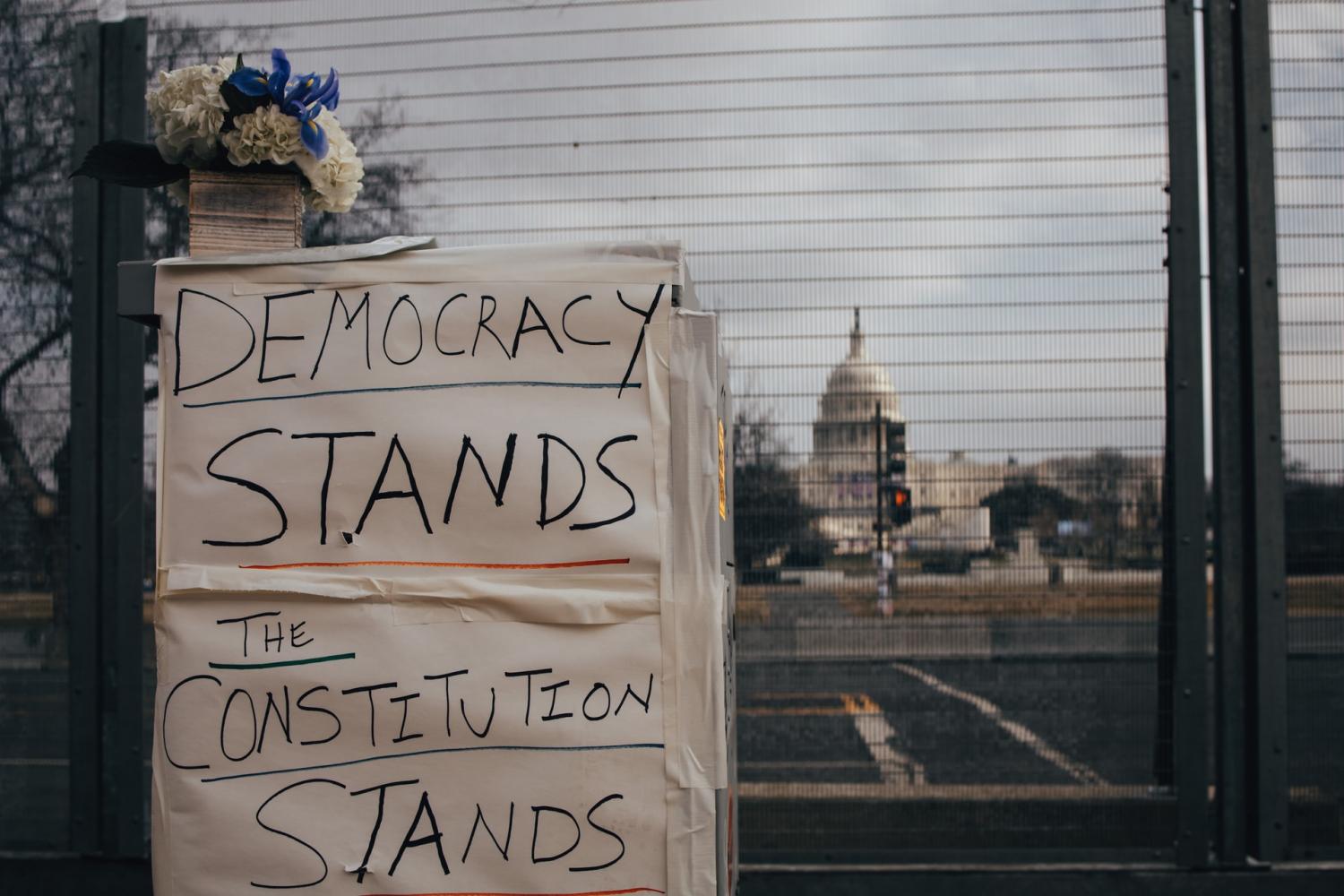
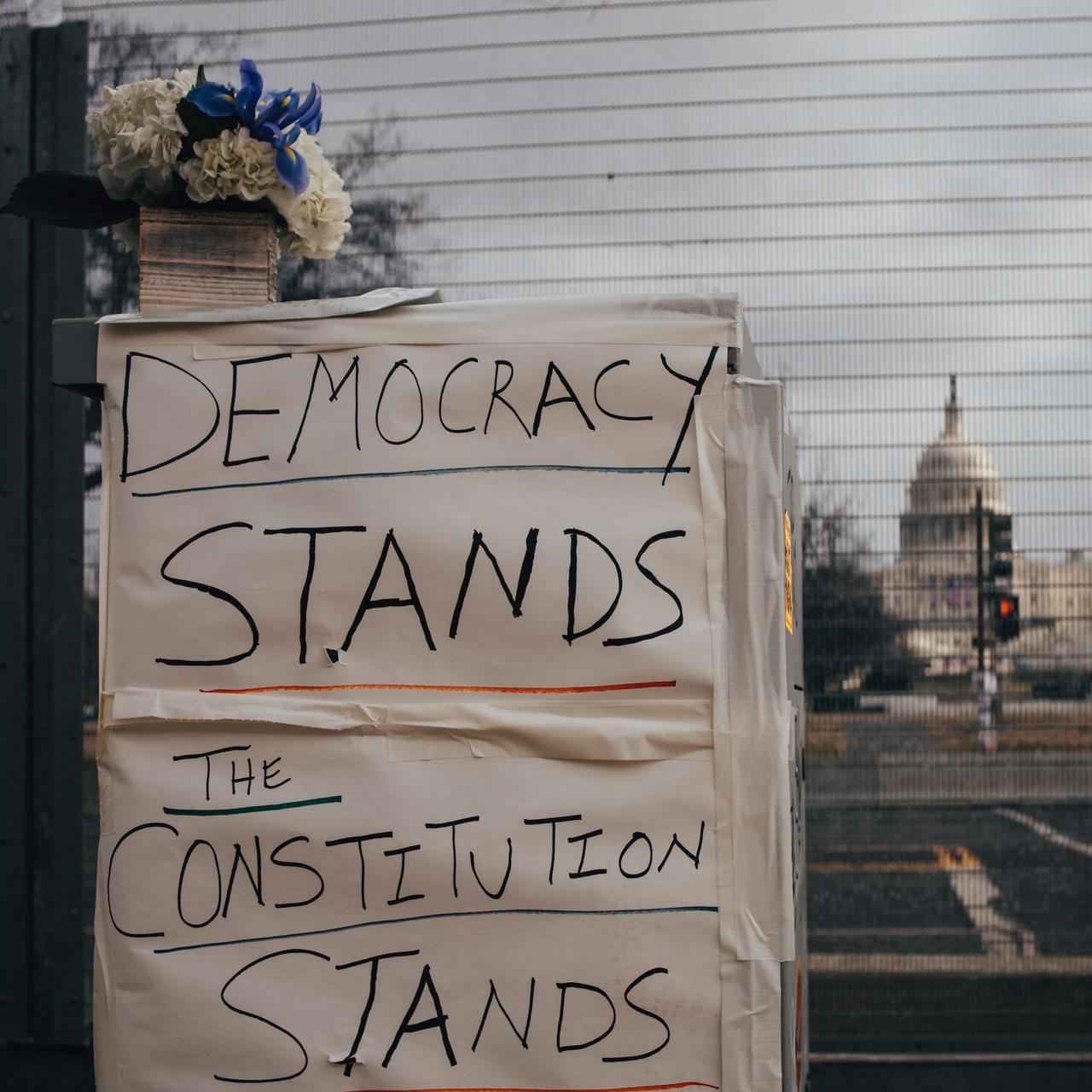
It’s an anniversary we’d prefer to not commemorate, but January 6 is a painful reminder of how divided the U.S. has become.
A year ago, we witnessed an outpouring of statements from U.S. companies saying that they would do their part to hold the 147 politicians who supported the insurrection at the U.S. Capitol responsible for their actions. Such responses came in the pledge to stop all political donations to members of the U.S. Congress who helped spark the ransacking of the Capitol or voted against certifying the Electoral College results.
Since last winter, it turned out many of those companies have backtracked on those promises, yet at least seven of them have made it clear nothing has changed in how they’ve approached the actions that surrounded January 6.
Editor's note: Be sure to subscribe to our Brands Taking Stands newsletter, which comes out every Wednesday.
Over the past year, independent journalist Judd Legum and his colleagues at the newsletter Popular Information have been tracking the companies that have pledged to not support members of Congress who objected to certifying the results of the 2020 U.S. presidential election – as well as those corporations that have since resumed cutting checks for those same politicians and the political action committees (PACs) that funnel money to them.
At last check, Legum’s January 6 corporate accountability index has found that only 36 of the dozens of companies that had promised to end such political donations have continued doing so. During 2021, those corporations did not donate any funds to members of the U.S. House and Senate nor any PACs.
But of the 180-plus companies that Popular Information queried about their political donations in 2022, only seven have responded with an explicit promise to withhold any funding during 2022. Those companies are AirBnb, American Express, BASF, Dow, Eversource Energy, Lyft and Microsoft.
The silence of the other 170 or so companies is something to worry about, says Popular Information.
“So dozens of major companies cut off corporate PAC donations to Republican objectors in 2021 but, at this point, most are keeping their options open for 2022. It's a worrisome sign for the future of democracy,” concluded Legum.
Image credit: Brendan Beale via Unsplash
Inequality Shown in 10 Charts: How the System Failed Workers in 2021


It’s been clear that the two-year-old pandemic has widened inequality between the haves and the have-nots. Yet to really understand what’s happened since early 2020, it’s important to take a look at the 10 graphs that Sarah Anderson and Brian Wakamo recently put together for Inequality.org.
Let’s start with the big numbers. While the combined wealth of the 745 U.S. billionaires surged 70 percent in 2021, and corporate profits increased 50 percent, it was a different story for workers at the bottom of the American pyramid. True, wages went up by 17 percent; but that 8 percent rise in consumer prices took a sizable bite out of any pay increases.
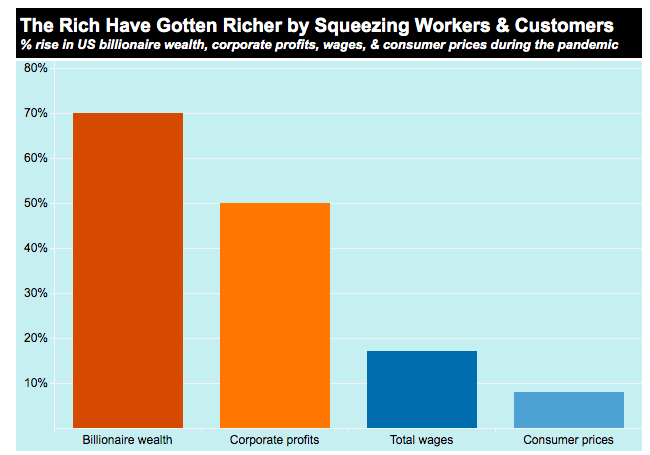
Yet, it’s not a simple case of the rich getting richer and the poor getting poorer. In fact, we can make the case that now, inequality can be traced to the rich squeezing the poorer. The data and facts are there, and companies would be wise to be aware of what’s going on in the U.S. economy before touting their latest “good work” for their employees and communities.
What do we mean? For example, during the third quarter of 2021, corporate profits spiked upward to a record $2.5 billion, largess that largely benefitted these companies’ executives and shareholders. “One factor behind the profits spike: giant corporations have used the excuse of pandemic-related supply chain bottlenecks to jack up prices for gasoline, food, and other essentials,” concluded Anderson and Wakamo.
Editor's note: Be sure to subscribe to our Brands Taking Stands newsletter, which comes out every Wednesday.
The stories out there back up the work of Inequality.org. Check out the summaries of investor calls by America’s largest companies that sell essentials such as food and consumer products.
“A key reason companies are able to succeed with these hikes is that so many of them are doing it,” Dominick Reuter wrote last fall for Business Insider. “If only Unilever charged more, that could drive shoppers to choose an offering from Colgate-Palmolive or P&G. When all of them do it, you don't have a choice.”
It’s true that at a macro level, the U.S. has enjoyed a strong job market. But again, looking beyond the numbers reveals more disparities behind the inequality gap. True, at last check, unemployment has dipped to 4.2 percent, one-third lower than at the beginning of 2021. But while Whites are unemployed at a rate of only 4 percent, the percentage of Blacks who are unemployed is almost double that rate.
As with any data point, the U.S. unemployment rate at face value doesn’t share some of the more disturbing realities about inequality and the state of the labor market. At least 3.5 million Americans have left the job force for a host of reasons. Black women have faced the steepest drop, as just over 60 percent of them are actively working, a decrease sharper than that of Hispanic and White women.
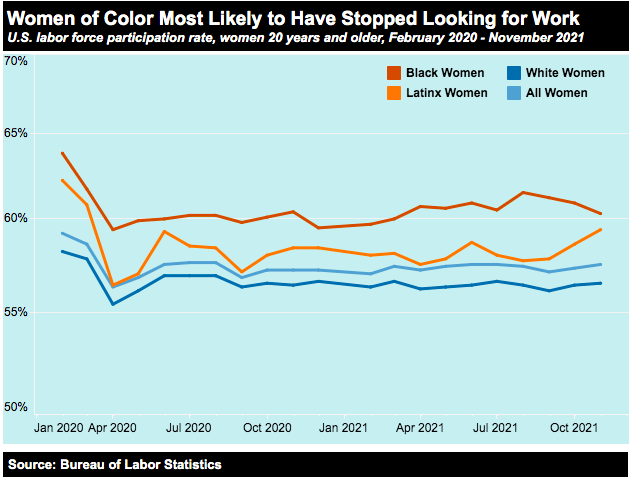
Going back to those wage increases: Anderson and Wakamo argue that such raises were the results of strikes and other actions that occurred that spurred companies to increase their minimum hourly wages. But considering the $234 billion that companies spent on stock buybacks last year, the results have only led an increase in the pay of executives – not capital investments or wage increases that could have helped narrowed inequality in the U.S. while motivating workers to stay on the job.
Meanwhile, political polarization in Washington has stymied any investments and policies that could have given more citizens in this country a much-needed and deserved break.
Anderson and Wakamo released these charts before it became clear that “Build Back Better” would die on Capitol Hill due to a certain U.S. senator; clearly, they had some hope that 2022 would not be so bleak for America’s wage earners. “While the 2021 debate over spending and tax policies has dragged on too long, it’s encouraging that the central question has been how much revenue to raise from the rich to invest in human needs,” they said. “This represents a long-overdue rejection of the failed ‘trickle down’ theories the wealthy and their advocates in Congress have used to justify tax cuts and other economic policies that benefit the rich at the expense of the rest of us.”
Image credit: Blake Carpenter via Unsplash; graphs courtesy Inequality.org